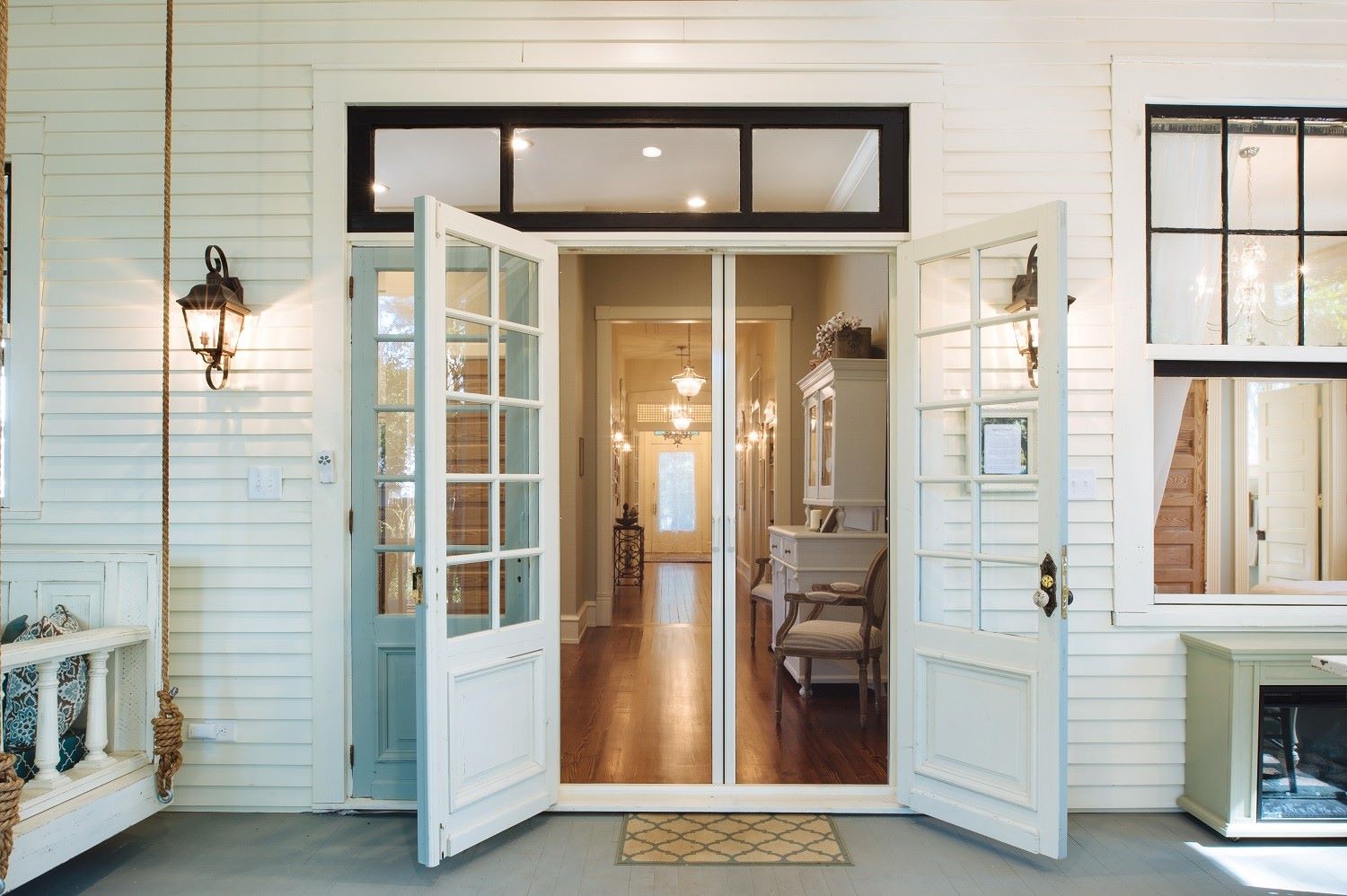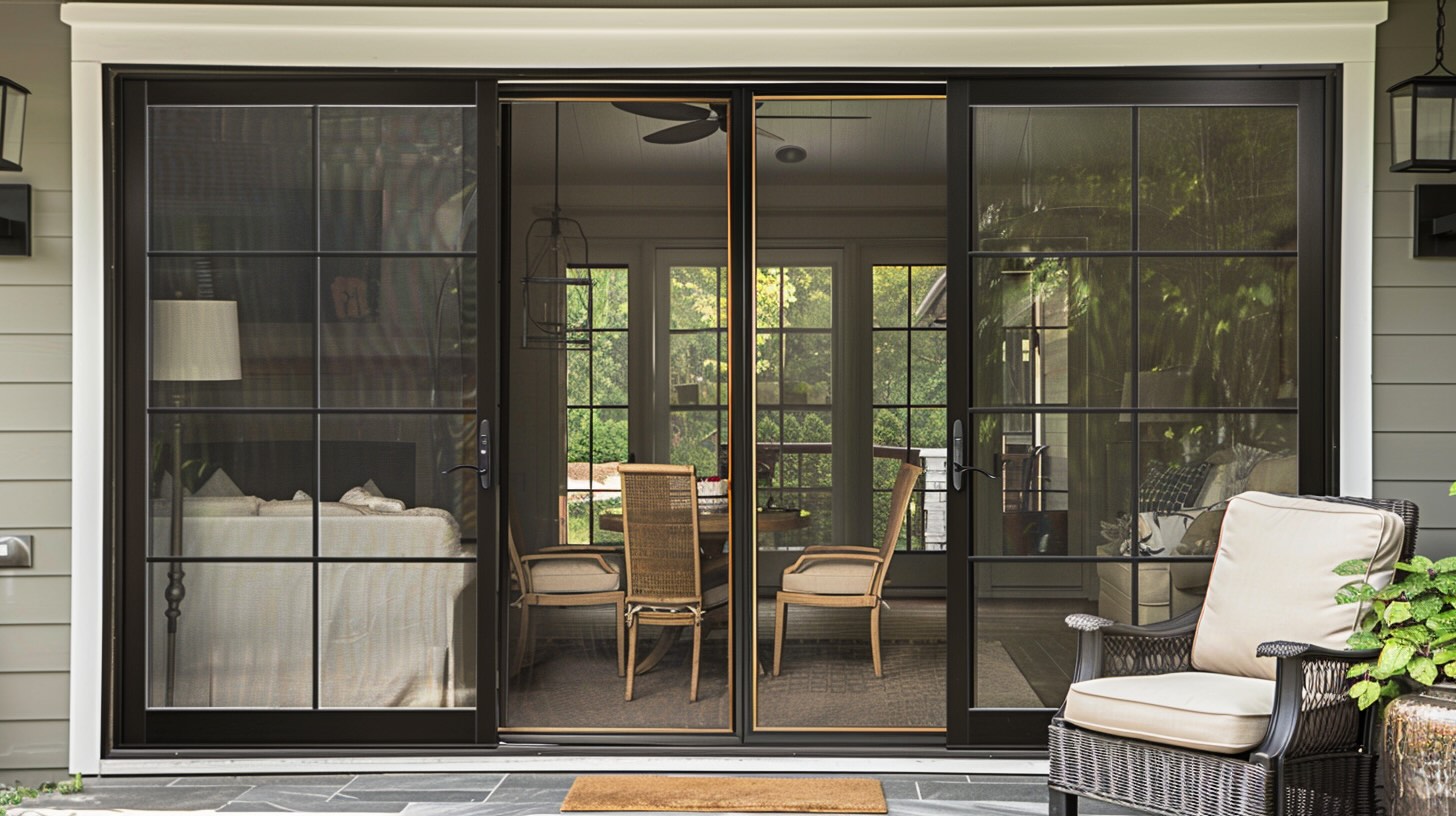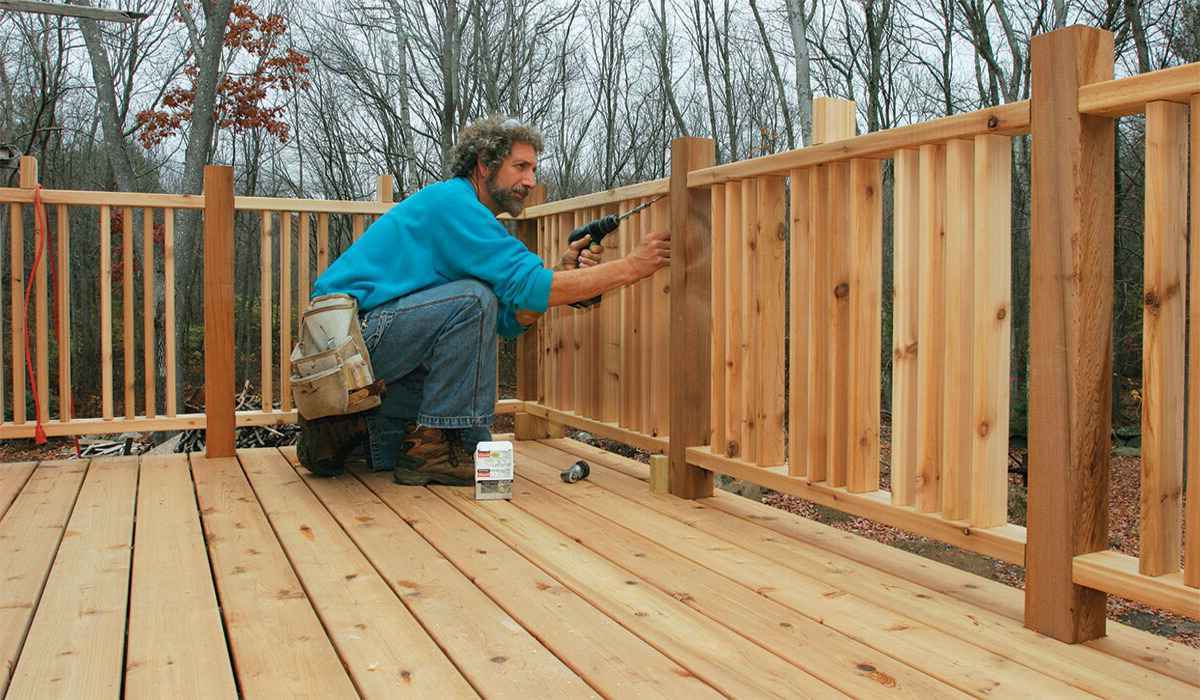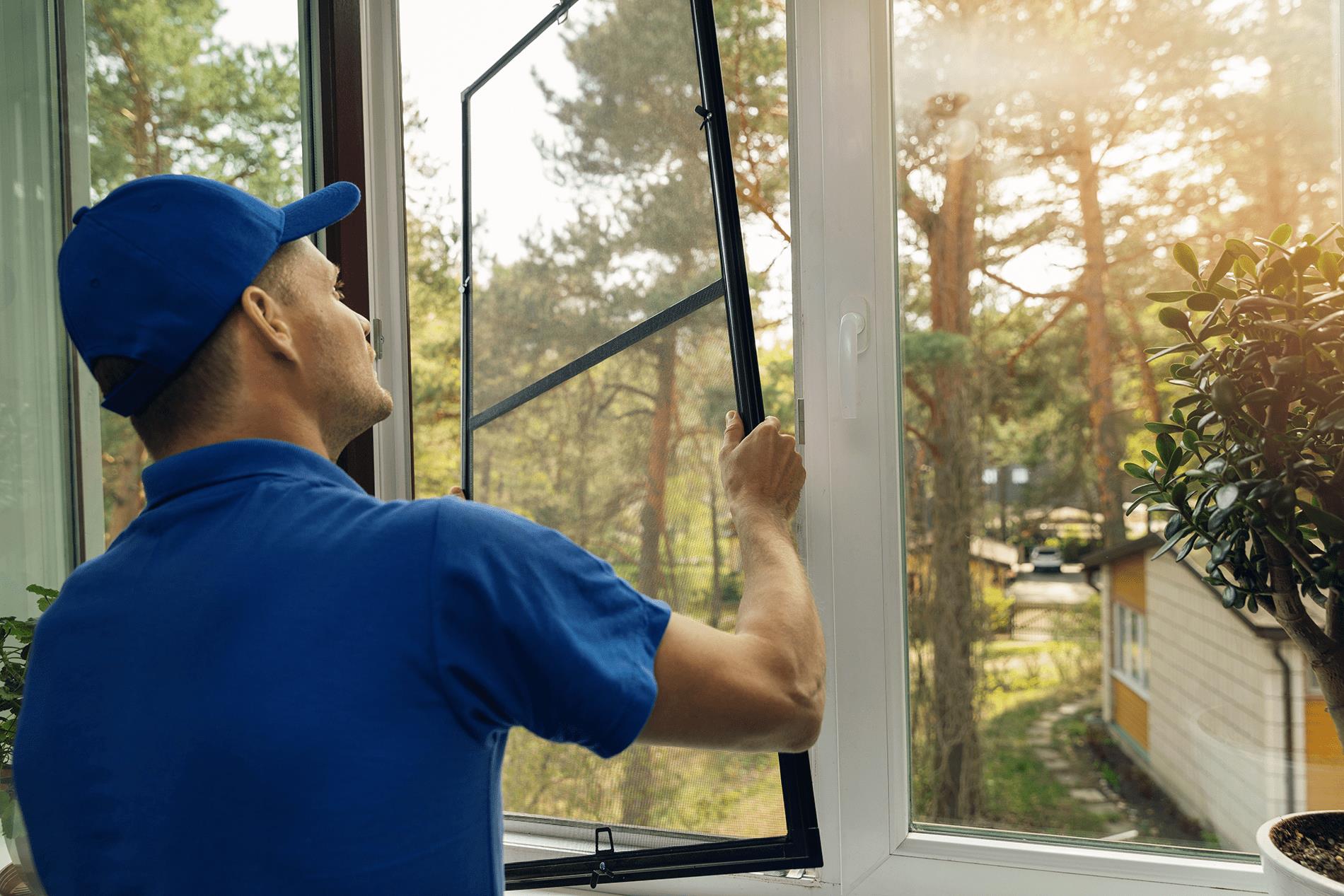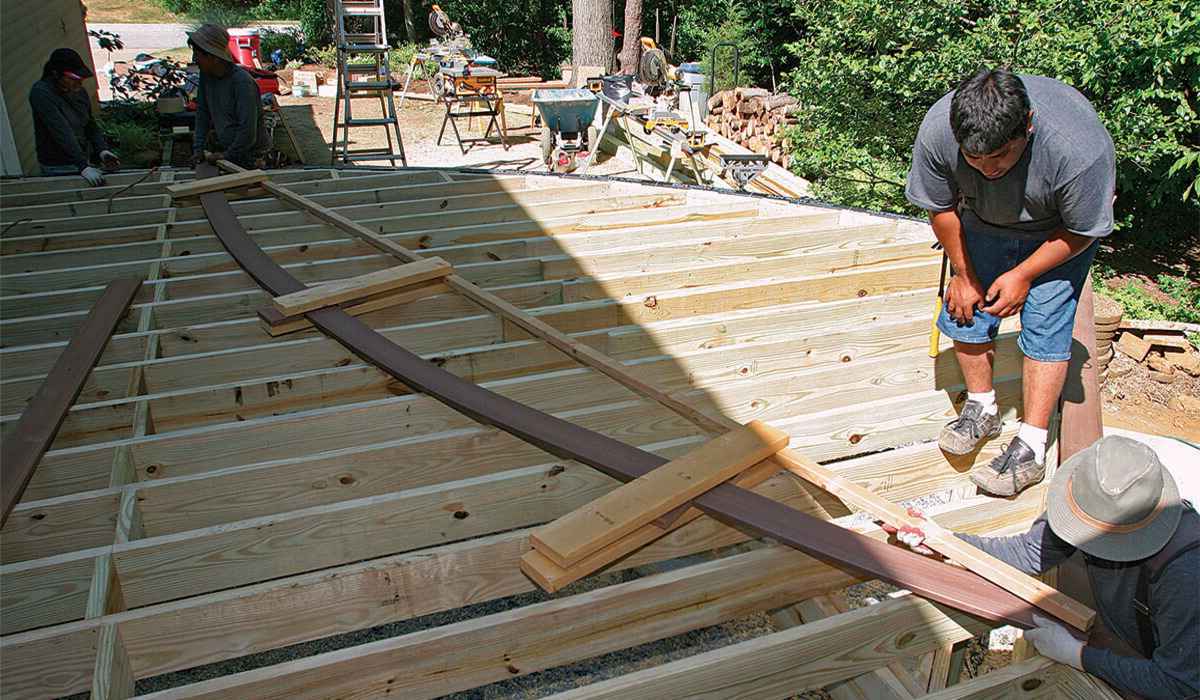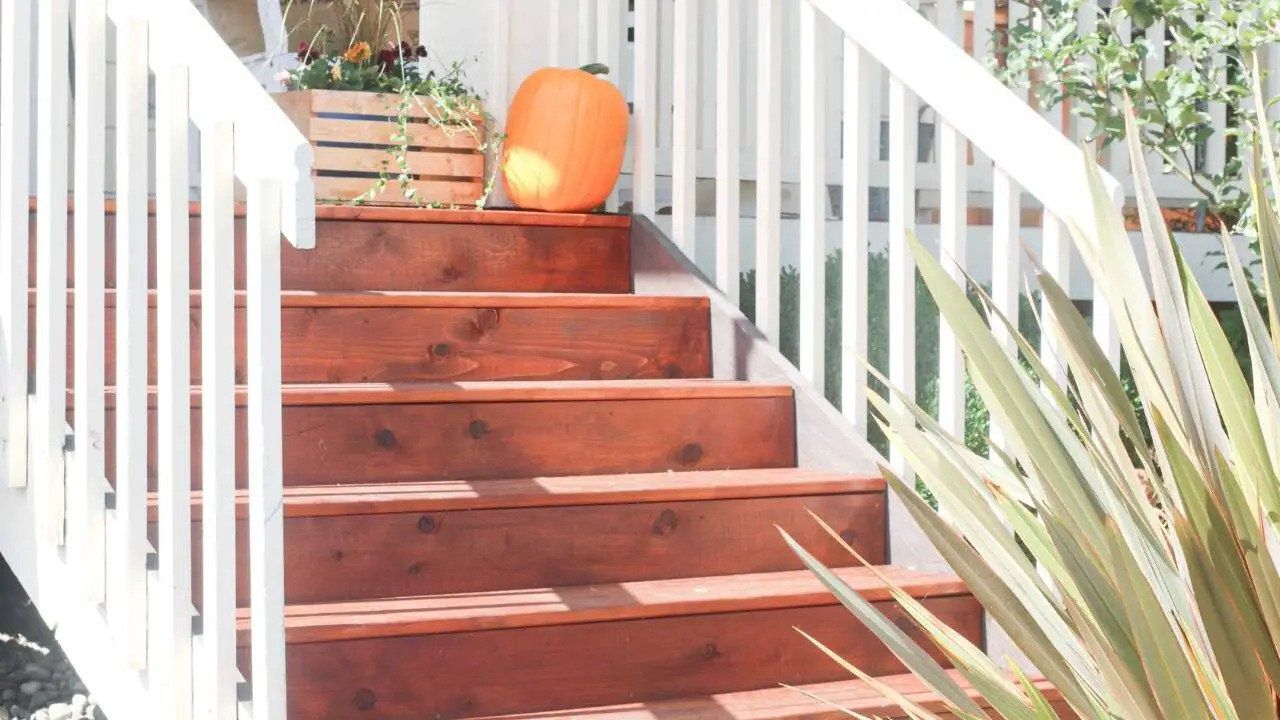Home>Create & Decorate>DIY & Crafts>How To Screen In A Deck
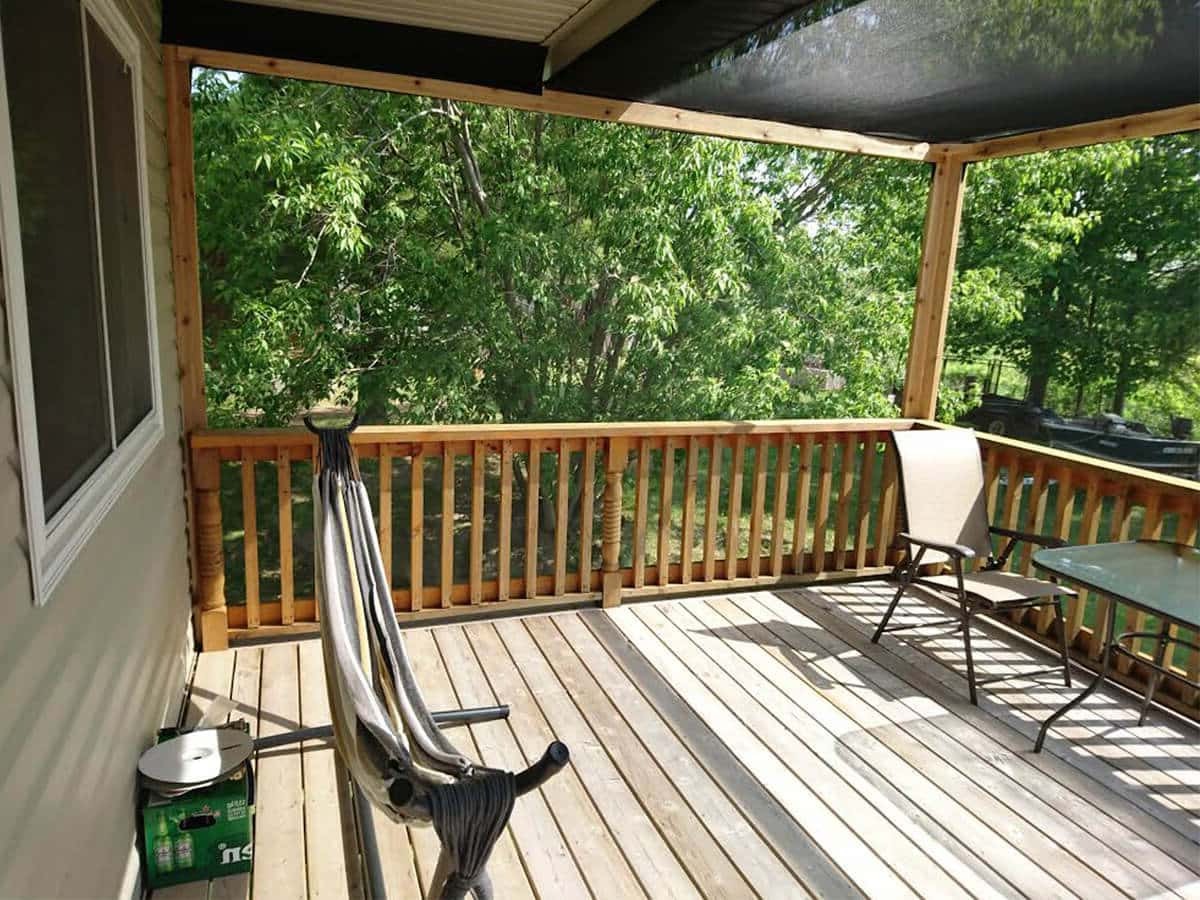

DIY & Crafts
How To Screen In A Deck
Published: February 24, 2024

Content Creator specializing in woodworking and interior transformations. Caegan's guides motivate readers to undertake their own projects, while his custom furniture adds a personal touch.
Learn how to screen in a deck with our easy DIY & Crafts guide. Create a cozy outdoor space and enjoy the benefits of a screened-in deck.
(Many of the links in this article redirect to a specific reviewed product. Your purchase of these products through affiliate links helps to generate commission for Twigandthistle.com, at no extra cost. Learn more)
Introduction
Screening in a deck is a fantastic way to transform an ordinary outdoor space into a versatile and enjoyable area that can be used throughout the year. Whether you want to create a bug-free zone for relaxation, a cozy spot for entertaining, or a sheltered space for enjoying the outdoors, a screened-in deck offers a perfect solution. By following the steps outlined in this guide, you can learn how to screen in a deck and elevate your outdoor living experience.
A screened-in deck provides numerous benefits, including protection from insects, added privacy, and a shield from the elements. It allows you to enjoy the fresh air and natural surroundings without the nuisance of bugs or harsh weather conditions. Additionally, a screened-in deck can increase the value of your home and expand your living space, making it a worthwhile investment for both your comfort and property value.
Whether you are a seasoned DIY enthusiast or a novice looking to take on a new project, screening in a deck can be a rewarding and achievable endeavor. With careful planning, the right materials, and step-by-step guidance, you can successfully create a screened-in oasis that complements your lifestyle and enhances your outdoor enjoyment.
In the following sections, we will delve into the essential steps for screening in a deck, from initial planning and material selection to frame construction, screen installation, and finishing touches. By following these steps, you can confidently embark on this project and bring your vision of a screened-in deck to life. Let's begin the journey of transforming your deck into a functional and inviting space that can be enjoyed for years to come.
Read more: How to Make DIY Solar Screens
Step 1: Planning and Designing Your Screened-In Deck
Planning and designing your screened-in deck is the crucial first step in creating a functional and inviting outdoor space. This phase sets the foundation for the entire project, ensuring that the end result aligns with your vision and meets your specific needs. Here's a detailed overview of the key considerations for planning and designing your screened-in deck:
Assess Your Needs and Goals
Before diving into the planning process, take some time to assess your needs and goals for the screened-in deck. Consider how you intend to use the space – whether it's for outdoor dining, relaxation, entertaining, or a combination of activities. Understanding your primary objectives will guide the design and layout decisions, ensuring that the screened-in deck caters to your lifestyle and preferences.
Determine the Location and Size
Evaluate the existing deck or the area where you plan to build the deck. Consider factors such as sun exposure, views, and proximity to the house. Determine the optimal location for the screened-in deck based on these considerations. Additionally, decide on the size of the deck, taking into account the available space and the activities you envision for the area. A well-planned layout will maximize functionality and visual appeal.
Explore Design Options
Explore various design options for the screened-in deck, including architectural styles, roof types, and railing designs. Consider how the screened-in structure will integrate with the existing architecture of your home and the surrounding landscape. Take inspiration from home improvement magazines, online resources, and local home design to gather ideas that resonate with your aesthetic preferences and complement your property.
Read more: How to Build Retractable Window Screens
Obtain Necessary Permits
Check with your local building department to determine if permits are required for constructing a screened-in deck. Understanding the permit requirements and building codes is essential to ensure compliance and avoid potential issues during the construction process. Obtain the necessary permits and approvals before proceeding with the project to adhere to legal and safety standards.
Create a Detailed Plan
Once you have gathered insights and made key decisions, create a detailed plan for the screened-in deck. Sketch out the layout, including the placement of doors, windows, and any additional features. Consider the flow of traffic, furniture arrangement, and functional zones within the deck space. A well-thought-out plan will serve as a roadmap for the subsequent phases of the project.
By carefully planning and designing your screened-in deck, you can lay the groundwork for a successful and satisfying construction process. This initial phase sets the stage for bringing your vision to fruition and ensures that the screened-in deck aligns with your lifestyle, aesthetic preferences, and practical needs. With a clear plan in place, you can proceed to the next steps with confidence and clarity, moving closer to enjoying your transformed outdoor oasis.
Step 2: Choosing the Right Materials
Selecting the appropriate materials is a pivotal aspect of creating a durable and visually appealing screened-in deck. The materials chosen for the project will directly influence the deck's structural integrity, aesthetic appeal, and long-term maintenance requirements. By carefully considering the following factors and making informed choices, you can ensure that your screened-in deck is constructed with high-quality materials that align with your vision and functional needs.
Consider the Frame Material
The frame serves as the backbone of the screened-in deck, providing support for the structure and screens. When choosing the frame material, factors such as durability, resistance to weather elements, and compatibility with the existing deck should be taken into account. Common options for frame materials include pressure-treated lumber, cedar, and composite materials. Each material has its unique characteristics, such as resistance to rot, insect infestation, and moisture, making it essential to evaluate the pros and cons of each option based on your specific requirements.
Read more: How to Build a DIY Garage Door Screen
Evaluate Screen Material Options
The selection of screen material is crucial for achieving the desired level of visibility, ventilation, and durability. Consider the different types of screening materials available, such as fiberglass, aluminum, and specialty screening designed to resist damage from pets or harsh weather. Factors to consider include the screen's transparency, UV resistance, and ability to withstand wear and tear over time. Additionally, the color and texture of the screen material can contribute to the overall aesthetic of the screened-in deck, complementing the design and enhancing the outdoor ambiance.
Choose Suitable Fasteners and Hardware
Selecting the right fasteners and hardware is essential for ensuring the structural stability and longevity of the screened-in deck. Stainless steel or corrosion-resistant fasteners are recommended to prevent rust and deterioration, especially in outdoor environments. Additionally, consider the hardware required for attaching the screens securely to the frame, such as screen clips, spline, and corner connectors. By choosing high-quality fasteners and hardware, you can enhance the overall integrity of the screened-in deck and minimize maintenance needs over time.
Explore Roofing and Trim Options
If your screened-in deck includes a roof or requires trim elements, carefully evaluate the available options for roofing materials and trim details. Common roofing materials for screened-in decks include shingles, metal roofing, and polycarbonate panels, each offering distinct advantages in terms of durability, aesthetics, and weather resistance. Similarly, trim elements such as fascia boards, corner caps, and decorative moldings contribute to the deck's visual appeal and provide a finished look. By exploring roofing and trim options, you can complete the overall design of the screened-in deck with cohesive and functional elements.
By thoughtfully considering the frame material, screen material, fasteners and hardware, as well as roofing and trim options, you can make informed decisions when choosing the right materials for your screened-in deck. Each material selection contributes to the overall quality, functionality, and aesthetic of the deck, ensuring that it meets your expectations and stands the test of time. With the right materials in place, you can proceed to the next phase of the project, ready to bring your vision of a screened-in deck to fruition.
Step 3: Building the Frame
Building the frame is a pivotal phase in the construction of a screened-in deck, as it forms the structural skeleton that supports the entire enclosure. The frame not only provides stability and strength but also serves as the framework for attaching the screens and other essential components. To ensure the successful construction of the frame, it is essential to follow a systematic approach and adhere to best practices in deck framing.
Read more: How to Make DIY Window Screens
Assess Existing Structure and Prepare the Site
Before commencing the frame construction, carefully assess the existing deck structure to determine its condition and suitability for supporting the screened-in enclosure. Inspect the integrity of the deck posts, beams, and joists, ensuring that they are structurally sound and capable of accommodating the additional load of the screened-in framework. If necessary, reinforce or replace any compromised structural elements to ensure a solid foundation for the frame.
Prepare the site by clearing the area of any obstructions and debris, creating a clean and accessible workspace for the frame construction. Take precise measurements and mark the layout of the frame, accounting for the placement of doors, windows, and any additional features. Proper site preparation sets the stage for a smooth and efficient frame assembly process.
Select and Install the Frame Material
Choose the appropriate frame material based on the planned design, structural requirements, and aesthetic preferences. Common options include pressure-treated lumber, cedar, or composite materials, each offering distinct advantages in terms of durability, resistance to decay, and overall appearance. Cut the framing members to the specified dimensions, ensuring accurate and precise cuts for seamless assembly.
Install the frame material according to the predetermined layout, securing the joists, beams, and posts in accordance with local building codes and best construction practices. Use galvanized or stainless steel fasteners to attach the frame components, ensuring secure connections that withstand outdoor exposure and environmental factors. Pay careful attention to proper spacing and alignment to maintain structural integrity and support the weight of the screened-in enclosure.
Incorporate Structural Support and Reinforcement
Integrate structural support elements, such as diagonal bracing and additional framing members, to enhance the stability and rigidity of the frame. Diagonal bracing helps prevent lateral movement and sway, especially in larger screened-in deck structures, ensuring a solid and secure framework. Consider the load-bearing capacity of the frame and reinforce critical areas as needed to accommodate the screens and roofing elements.
Ensure that all connections and joints are properly secured and aligned, minimizing any potential for shifting or settling over time. By incorporating strategic reinforcement and support measures, you can create a robust frame that forms the foundation for a durable and long-lasting screened-in deck.
Inspect and Prepare for Screen Installation
Upon completing the frame construction, conduct a thorough inspection to verify the structural integrity and alignment of the frame. Address any discrepancies or issues promptly, ensuring that the frame is ready to receive the screens and additional components. Prepare the frame for screen installation by smoothing any rough edges, removing protruding fasteners, and ensuring a clean and even surface for attaching the screens.
By meticulously following the steps for building the frame, you can establish a solid and reliable foundation for the screened-in deck enclosure. The careful selection and installation of frame materials, coupled with strategic reinforcement and meticulous attention to detail, contribute to the overall quality and structural integrity of the frame. With the frame in place, you are prepared to proceed to the next phase of the project, bringing you closer to the realization of your screened-in deck vision.
Read more: How To Build A Screened In Porch On Concrete
Step 4: Installing the Screens
Installing the screens is a pivotal phase in the construction of a screened-in deck, as it directly contributes to the functionality, comfort, and aesthetic appeal of the outdoor enclosure. The screens serve as a barrier against insects, debris, and harsh weather while allowing fresh air and natural light to permeate the space. By following a systematic approach and employing best practices for screen installation, you can ensure a seamless and effective process that results in a well-enclosed and inviting deck area.
Prepare the Screening Materials
Before commencing the installation, gather the necessary screening materials, ensuring that they align with the design and functional requirements of the screened-in deck. Carefully measure and cut the screens to fit the openings within the frame, allowing for a slight overlap to facilitate secure attachment. Consider the visibility, ventilation, and durability of the screening material, selecting options that complement the overall design and provide optimal comfort within the enclosed space.
Secure the Screens to the Frame
Begin the installation process by securing the screens to the frame, starting from one end and working methodically across each opening. Utilize screen clips or spline, depending on the chosen screening material, to fasten the screens securely within the frame. Ensure that the screens are taut and free from wrinkles or sagging, providing a smooth and uniform surface that effectively encloses the deck area. Pay attention to the alignment and tension of the screens, making adjustments as needed to achieve a consistent and professional installation.
Address Corners and Transitions
When installing the screens, pay special attention to corners and transitions where multiple screen panels meet. Carefully miter the screen material at corners to create clean and seamless junctions, ensuring a polished and cohesive appearance. Use corner connectors or specialized framing elements to reinforce and stabilize the screen joints, promoting durability and structural integrity. Address any overlapping sections or transitions between different screen panels, ensuring a continuous and secure enclosure without compromising the visual appeal.
Read more: How to Build Cat-Proof Window Screens
Verify Stability and Functionality
Upon completing the screen installation, conduct a comprehensive inspection to verify the stability, functionality, and overall quality of the enclosure. Test the doors, windows, or any access points within the screened-in deck to ensure smooth operation and proper sealing. Address any loose or uneven sections of the screens, making necessary adjustments to achieve a consistent and secure installation. Verify that the screens effectively block insects and debris while allowing for adequate airflow and visibility, creating a comfortable and inviting outdoor space.
Add Finishing Touches
With the screens securely installed, consider adding finishing touches to enhance the overall appeal and functionality of the screened-in deck. Install trim elements, such as screen moldings or caps, to conceal fasteners and provide a polished edge around the screen openings. Consider additional features, such as decorative door handles, latches, or kick plates, to personalize the screened-in enclosure and elevate its visual charm. By adding thoughtful finishing touches, you can complete the transformation of the deck into a well-appointed and inviting outdoor retreat.
By meticulously following the steps for installing the screens, you can achieve a well-enclosed and functional screened-in deck that aligns with your vision and enhances your outdoor living experience. The careful selection and installation of screening materials, coupled with attention to detail and precision, contribute to the overall quality and comfort of the screened-in deck. With the screens in place, you are prepared to proceed to the final phase of the project, bringing you closer to enjoying your transformed outdoor oasis.
Step 5: Adding Finishing Touches
With the screens securely installed and the structural framework in place, the final phase of creating a screened-in deck involves adding finishing touches to elevate the overall aesthetic appeal, functionality, and comfort of the outdoor enclosure. This stage allows for personalization and attention to detail, transforming the screened-in deck into a well-appointed and inviting outdoor retreat.
Install Decorative Trim and Molding
To enhance the visual appeal and provide a polished finish to the screened-in deck, consider installing decorative trim and molding around the screen openings. Trim elements such as screen moldings or caps not only conceal fasteners but also create a clean and refined edge, adding a touch of sophistication to the enclosure. Carefully selected trim details contribute to the overall cohesiveness of the design, creating a seamless transition between the screens and the surrounding framework.
Read more: How to Make DIY Car Window Screens
Personalize Access Points
Consider personalizing the access points, such as doors and windows, within the screened-in deck. Install decorative door handles, latches, or kick plates that complement the overall aesthetic and reflect your personal style. These subtle yet impactful details add character to the enclosure, creating a welcoming and customized entry experience. By incorporating personalized elements, you can infuse the screened-in deck with a sense of individuality and charm.
Integrate Lighting Features
Enhance the ambiance and functionality of the screened-in deck by integrating lighting features that extend its usability into the evening hours. Consider installing soft ambient lighting, such as string lights, lanterns, or sconces, to create a warm and inviting atmosphere. Strategic placement of lighting fixtures can accentuate architectural elements, provide task lighting for specific areas, and contribute to a cozy and enchanting outdoor setting.
Furnish and Decorate the Space
Complete the transformation of the screened-in deck by furnishing and decorating the space to suit your intended use. Select outdoor furniture that is both comfortable and durable, creating designated areas for dining, lounging, and relaxation. Incorporate weather-resistant textiles, cushions, and accessories to add color, texture, and personality to the space. Consider potted plants, outdoor rugs, and decorative accents to infuse the screened-in deck with a welcoming and inviting ambiance.
Maintain and Care for the Enclosure
Once the finishing touches are in place, establish a maintenance routine to preserve the beauty and functionality of the screened-in deck. Regularly clean the screens, inspect the structural elements, and address any maintenance needs promptly to ensure the longevity of the enclosure. By maintaining the screened-in deck with care and attention, you can continue to enjoy its benefits and appeal for years to come.
By adding thoughtful finishing touches, the screened-in deck is transformed into a well-appointed and inviting outdoor retreat, tailored to your preferences and lifestyle. The integration of decorative trim, personalized elements, lighting features, and carefully selected furnishings creates a cohesive and welcoming outdoor space that can be enjoyed throughout the seasons. With the completion of the finishing touches, the screened-in deck stands as a testament to meticulous craftsmanship and thoughtful design, ready to enrich your outdoor living experience.
Read more: How to Build a DIY Magnetic Screen Door
Conclusion
In conclusion, the process of screening in a deck presents a transformative opportunity to create a versatile and inviting outdoor space that enhances both the functionality and aesthetic appeal of your home. By following the comprehensive steps outlined in this guide, you can embark on the journey of constructing a screened-in deck with confidence and clarity, bringing your vision to life while elevating your outdoor living experience.
The initial phase of planning and designing your screened-in deck sets the stage for a successful project, allowing you to assess your needs, determine the optimal location and size, explore design options, and obtain necessary permits. This crucial planning phase ensures that the screened-in deck aligns with your lifestyle, aesthetic preferences, and practical requirements, laying the groundwork for a well-conceived and purposeful outdoor space.
The selection of the right materials is pivotal in creating a durable and visually appealing screened-in deck. By carefully considering the frame material, screen material, fasteners and hardware, as well as roofing and trim options, you can make informed choices that contribute to the overall quality, functionality, and longevity of the deck. Thoughtful material selection ensures that the screened-in deck meets your expectations and stands the test of time.
Building the frame and installing the screens are fundamental phases that form the structural and enclosure elements of the screened-in deck. By following best practices in deck framing and meticulous screen installation, you can establish a solid foundation and a well-enclosed space that effectively shields against insects and the elements while allowing for comfortable outdoor enjoyment.
Adding finishing touches, such as decorative trim, personalized elements, lighting features, and carefully selected furnishings, completes the transformation of the screened-in deck into a well-appointed and inviting outdoor retreat. These thoughtful details infuse the space with character, charm, and functionality, creating an outdoor oasis that can be enjoyed throughout the seasons.
In essence, screening in a deck is a rewarding endeavor that offers a multitude of benefits, including expanded living space, increased property value, and a versatile outdoor sanctuary for relaxation and entertainment. By embracing the process with enthusiasm and attention to detail, you can create a screened-in deck that reflects your personal style, enhances your home, and enriches your outdoor lifestyle for years to come.

